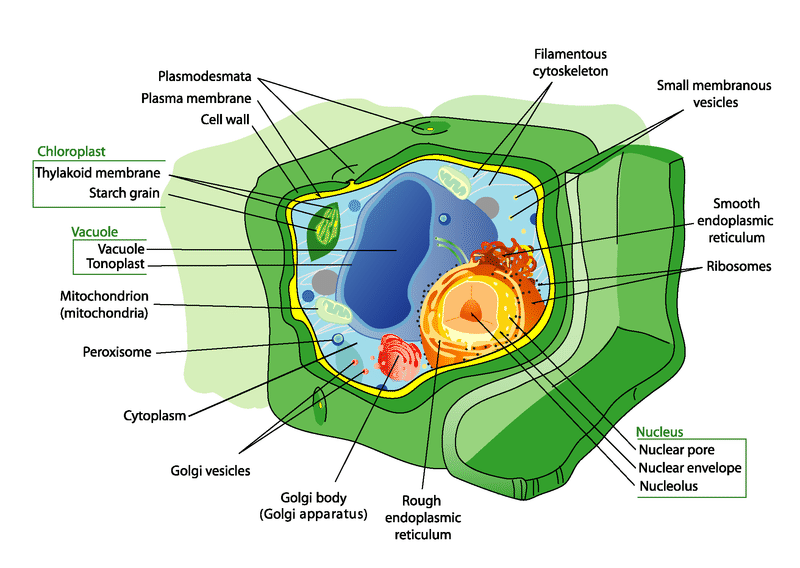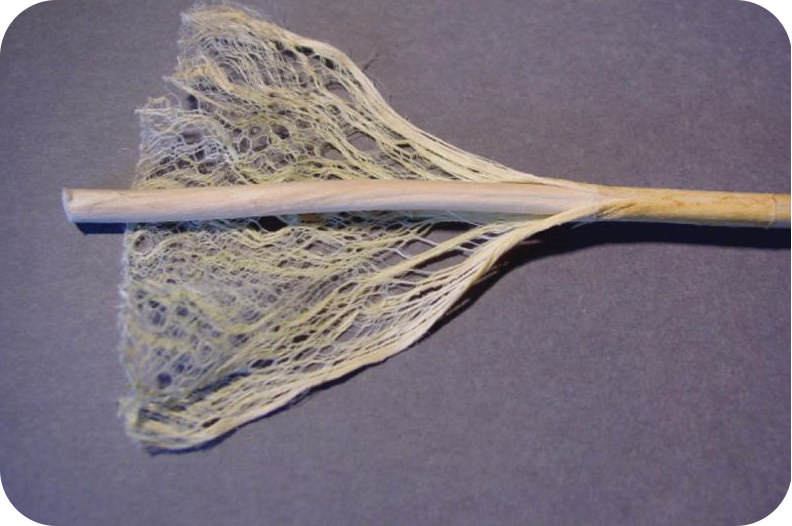工厂电池室
章节大纲
-
Why do plant cells look like little rectangles?
::为什么植物细胞看起来像小矩形?Notice how all the seem to stack on each other, with no spaces in between. Might this allow the cells to form structures that can grow upright?
::注意所有看起来都堆叠在一起, 彼此之间没有空隙。 这会允许细胞形成能够直立成长的结构吗 ?Organs in Plants?
::植物的器官吗?Your body includes organ systems , such as the , made of individual organs , such as the stomach , liver , and pancreas , which work together to carry out a certain function (in this case, breaking down and absorbing food). These organs, in turn, are made of different kinds of tissues , which are groups of cells which work together to perform a specific job. For example, your stomach is made of muscle tissue to facilitate movement and glandular tissue to secrete for chemical breakdown of food molecules. These tissues, in turn, are made of cells specialized in shape, size, and component , such as for energy and microtubules for movement.
::你的身体包括器官系统,例如由肠胃、肝脏和胰腺等个别器官组成的器官系统,这些器官合力执行某种功能(在这种情况下,分解和吸收食物),这些器官则由不同种类的组织组成,这些组织是合力执行特定任务的细胞组。例如,你的胃是由肌肉组织组成的,用腺组织组成,以方便运动,为食物分子的化学分解进行分解。而这些组织又由形状、大小和组成部分(如动能和微细胞)等专门细胞组成。Plants, too, are made of organs, which in turn are made of tissues. Plant tissues, like ours, are constructed of specialized cells, which in turn contain specific organelles. It is these cells, tissues, and organs that carry out the dramatic lives of plants.
::植物也由器官组成,而器官又由组织组成。 植物组织与我们一样,由专门细胞组成,这些细胞又包含特定的器官。 这些细胞、组织和器官是植物生机勃勃的生命的产物。Plant Cells
::工厂电池Plant cells resemble other eukaryotic cells in many ways. For example, they are enclosed by a plasma membrane and have a and other membrane-bound organelles. A typical plant cell is represented by the diagram in Figure .
::植物细胞在许多方面类似于其他表层细胞。例如,植物细胞被等离子膜封住,并有一个和其他含膜的有机体。图中图示了一个典型的植物细胞。Plant cells have all the same structures as animal cells, plus some additional structures. Can you identify the unique plant structures in the diagram?
::植物细胞结构与动物细胞结构完全相同,加上一些额外的结构。您能辨别图表中独特的植物结构吗?Plant Cell Structures
::工厂电池结构Structures found in plant cells but not cells include a large central vacuole , cell wall , and plastids such as .
::植物细胞中发现的结构,但不包括细胞,包括大型中央真空、细胞壁和诸如......等弹性体。-
The large
central vacuole
is surrounded by its own membrane and contains
and dissolved substances. Its primary role is to maintain pressure against the inside of the cell wall, giving the cell shape and helping to support the plant.
::大型中央真空体环绕着其本身的膜,内含和溶解物质,其主要作用是保持对细胞墙内的压力,给细胞形状,帮助支持工厂。 -
The
cell wall
is located outside the
. It consists mainly of
cellulose
and may also contain
lignin
, which makes it more rigid. The cell wall shapes, supports, and protects the cell. It prevents the cell from absorbing too much water and bursting. It also keeps large, damaging molecules out of the cell.
::细胞墙位于 。 细胞墙主要由纤维素组成, 也可能含有离心素, 使细胞更加硬。 细胞墙形成、 支撑和保护细胞, 防止细胞吸收过多的水和爆裂, 并且将大量有害分子从细胞中分离出来 。 -
Plastids
are membrane-bound organelles with their own
. Examples are chloroplasts and
chromoplasts
.
Chloroplasts
contain the green pigment
chlorophyll
and carry out
. Chromoplasts make and store other pigments. They give
flower
petals
their bright colors.
::聚氨酯是含有薄膜的有机物,有其本身的有机物。例如叶板和铬聚氨酯。氯甲醚含有绿色色素叶素并进行生产。铬聚氨酯制造并储存其他色素。它们给花瓣以亮亮的颜色。
Types of Plant Cells
::植物细胞种类There are three basic types of cells in most plants. These cells make up , which will be discussed in another concept. The three types of cells are described in Table . The different types of plant cells have different structures and functions.
::大多数工厂有三种基本类型的细胞。这些细胞组成,将在另一个概念中讨论。三种类型的细胞在表格中说明。不同类型的植物细胞有不同的结构和功能。Type of Cell Structure Functions Example Parenchymal cube-shaped
::立方形loosely packed
::散散散包装thin-walled
::薄壁relatively unspecialized
::相对非专门化contain chloroplasts
::含有氯白photosynthesis
::光合作用storage
::储存储存food storage tissues of potatoes
::土豆食品储存组织Collenchymal elongated
::长长irregularly thickened walls
::非正常厚厚墙壁support
::支助支助wind resistance
::防风防风strings running through a stalk of celery
::字符字符串通过一个切菜的尾巴运行Sclerenchymal very thick cell walls containing lignin support
::支助支助strength
::功 力数tough fibers in jute (used to make rope)
::黄麻中的硬纤维(用来做绳子)Summary
::摘要-
Plants have eukaryotic cells with large central vacuoles, cell walls containing cellulose, and plastids such as chloroplasts and chromoplasts.
::植物中含有大型中空气的乳房细胞、含有纤维素的细胞壁以及诸如叶板和铬等粘合物。 -
Different types of plant cells include parenchymal, collenchymal, and sclerenchymal cells. The three types differ in structure and function.
::不同种类的植物细胞包括近地点细胞、近地点细胞、近地点细胞和心肺细胞,这三种类型在结构和功能上各不相同。
Review
::回顾-
Identify three structures found in plant cells but not animal cells. What is the function of each structure?
::找出植物细胞中发现的三个结构,但不包括动物细胞。 每个结构的功能是什么? -
Describe parenchymal plant cells and state their functions.
::描述近角植物细胞并说明其功能。
-
The large
central vacuole
is surrounded by its own membrane and contains
and dissolved substances. Its primary role is to maintain pressure against the inside of the cell wall, giving the cell shape and helping to support the plant.




